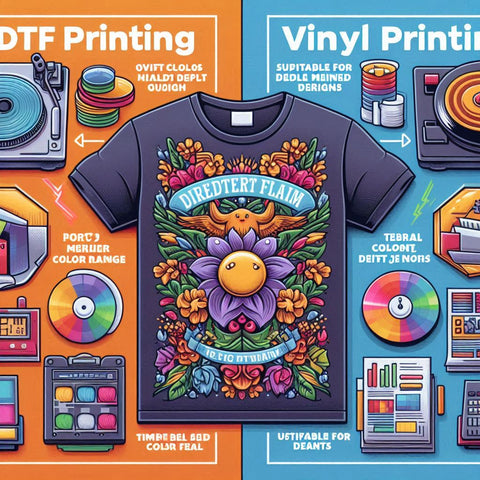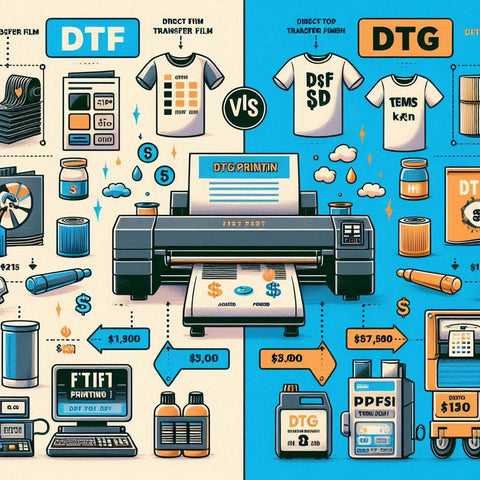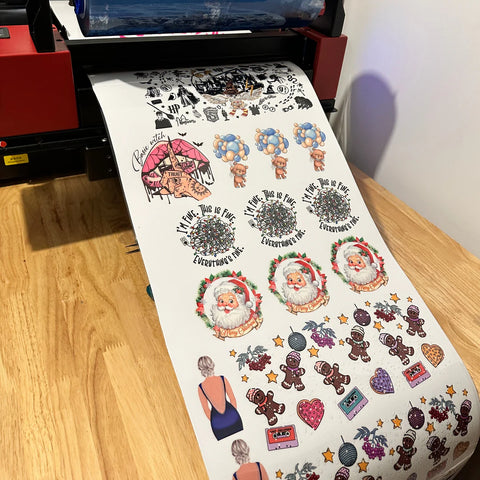DTF (Direct-to-Film) printing and vinyl printing are two popular methods for creating custom designs on fabrics. While both have their unique advantages, DTF printing is often considered better than vinyl for several reasons. Here’s a detailed comparison explaining why DTF might be a superior choice:
1. Versatility in Design
-
Detail and Complexity: DTF printing allows for intricate designs with fine details, gradients, and unlimited color options. This method is ideal for complex graphics, photographs, and artwork that require a high level of detail and color accuracy. In contrast, vinyl printing is limited to simpler designs with solid colors. Creating complex multi-color designs with vinyl involves layering multiple pieces, which can be time-consuming and challenging.
-
No Need for Weeding: With DTF printing, there is no need for weeding, which is the process of removing excess vinyl around the design. This makes DTF faster and easier for detailed designs, while vinyl requires meticulous weeding for every intricate cut.
2. Fabric Compatibility
-
Wide Range of Fabrics: DTF printing can be applied to a variety of fabrics, including cotton, polyester, blends, nylon, and more. This versatility makes it suitable for a broad range of applications, from T-shirts to jackets and even non-traditional materials like leather or denim. Vinyl, on the other hand, is best suited for cotton and polyester fabrics. Applying vinyl to some fabrics, like nylon or those with water-resistant coatings, can be problematic and may require special types of vinyl.
-
Soft and Flexible Finish: DTF transfers produce a soft, flexible print that moves with the fabric, providing a more comfortable feel. Vinyl can sometimes feel stiff or heavy, especially on lighter fabrics, which may not be as comfortable to wear.
3. Durability and Washability
-
Long-Lasting Prints: DTF prints are known for their durability and ability to withstand multiple washes without fading, cracking, or peeling. The print bonds directly to the fabric fibers, ensuring a strong, long-lasting finish. Vinyl prints can sometimes crack or peel over time, especially with repeated washing and drying. The adhesive backing of vinyl may degrade faster than the bond created by DTF printing.
-
Better for Outdoor Use: Due to its durability and ability to resist fading from UV exposure, DTF printing is better suited for outdoor garments and gear that need to withstand harsh conditions. Vinyl can fade or become brittle when exposed to prolonged sunlight.
4. Production Efficiency
-
Faster Production Times: DTF printing can be quicker than vinyl, especially for multi-color designs. Since the design is printed all at once on a film and then transferred to the fabric, there’s no need for multiple steps or layers. Vinyl requires cutting, weeding, and sometimes layering different colors, which can be time-consuming, especially for detailed designs.
-
No Color Limitations: With DTF printing, there are no restrictions on the number of colors or gradients that can be used in a single design. Vinyl, however, is limited by the color of the vinyl sheets available and the complexity of layering multiple colors.
5. Cost-Effectiveness
-
Lower Cost for Complex Designs: For intricate designs that require multiple colors, DTF printing is often more cost-effective than vinyl. The cost of materials and time required to produce multi-color vinyl designs can add up quickly. DTF allows for more economical production of complex graphics.
-
Economical for Small Runs: DTF is also more cost-effective for smaller runs or one-off designs, as it doesn’t require the same setup or labor-intensive processes as vinyl cutting and weeding.
Conclusion
DTF printing offers several advantages over vinyl printing, including greater versatility in design, broader fabric compatibility, superior durability, faster production times, and better cost-effectiveness for complex or small-scale projects. While vinyl still has its place, particularly for simple designs and certain applications, DTF is often the better choice for high-quality, detailed, and durable prints





Comments (0)
There are no comments for this article. Be the first one to leave a message!